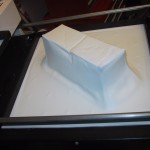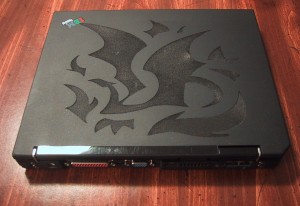
I used a laser cutter to decorate my “home” laptop. Using an Epilog Mini 45 watt laser cutter / engraver, I was able to cut out a good 0.5mm from the rubberized plastic coating on my Thinkpad X31’s cover. To get the cut this deep, I used 100% power and 5% laser speed at 300dpi, which took over 70 minutes, but the results are well worth the wait! Compare this to my laptop paint job on the “work” laptop.
Moving NTFS paritions using Ubuntu (Vista, XP)
This guide gives a good step by step procedure for moving a windows partition from one drive to another:
http://ubuntuforums.org/showthread.php?p=7742172
If you get an “autochk.exe not found” error message just after windows XP boots, it probably means that you have the partition type set incorrectly. Using fdisk under linux just use the “T” option to change the partition type to NTFS (hex 0x07 or number 7 in fdisk).
E-bike solar charging rack
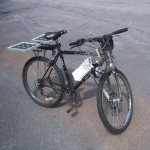 An electric powered bike makes it easier to go up hills, and can turn a ride to the train station from a workout into a commute. Typically however, the batteries need to be plugged in to charge after your trip. Although electricity is cheap, this does require that you have removable batteries (or wheel your bike into the house or bring a charger outside). I decided to use the sun to recharge my bike, seeing as how I would be parking my bike outside at a train station all day. This way, it can be fully charged and ready for the ride home when I return. Continue reading
An electric powered bike makes it easier to go up hills, and can turn a ride to the train station from a workout into a commute. Typically however, the batteries need to be plugged in to charge after your trip. Although electricity is cheap, this does require that you have removable batteries (or wheel your bike into the house or bring a charger outside). I decided to use the sun to recharge my bike, seeing as how I would be parking my bike outside at a train station all day. This way, it can be fully charged and ready for the ride home when I return. Continue reading
Bike Lighting: $15
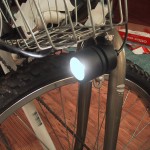 In case I need to commute home after dark on my electric bike, I added a front headlight (5 watt MR11 halogen) and a rear tail light (Red LED tail light for “off-road” use). The front headlight enclosure was designed to be used on a bike, and included a nice mounting bracket and enough cord that I could harvest some to run to the rear tail light. Black zip-ties hold the wires to the frame. The rear tail light had no enclosure, so I soldered the wire directly to it and epoxied it into the back of my rear rack. Both lights run off of only one of the 12v batteries through a 5A blade fuse and an automotive switch mounted under the battery pack. Continue reading
In case I need to commute home after dark on my electric bike, I added a front headlight (5 watt MR11 halogen) and a rear tail light (Red LED tail light for “off-road” use). The front headlight enclosure was designed to be used on a bike, and included a nice mounting bracket and enough cord that I could harvest some to run to the rear tail light. Black zip-ties hold the wires to the frame. The rear tail light had no enclosure, so I soldered the wire directly to it and epoxied it into the back of my rear rack. Both lights run off of only one of the 12v batteries through a 5A blade fuse and an automotive switch mounted under the battery pack. Continue reading
The $175 Electric Bike
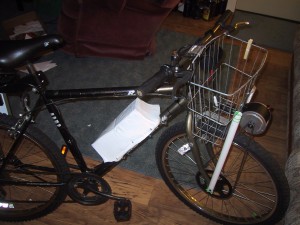
Electric bikes are expensive. Even if you buy the cheapest electric bike you can find on deep discount at walmart, it costs $300. (Formerly $400 before they deeply discounted it.) I decided to build my own out of surplus parts and things I could buy at the local Ace Hardware for less than $300. (Mostly, for the fun of the build.)
So, I bought a surplus motor controller, handlebar mounted throttle, and a 250 watt electric motor. I bolted the motor to the front of my used $20 bike, built a battery holder out of PVC pipes, and made a vacuum formed cover.
Continue reading
Vacuuform Battery Cover
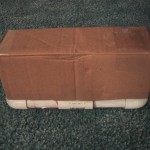 After building a PVC pipe battery holder for my electric bike, I used a vacuum form machine to make a polystyrene battery cover. I built up a cheap tool form using cardboard (which turned out to be too week, but it was quick).
After building a PVC pipe battery holder for my electric bike, I used a vacuum form machine to make a polystyrene battery cover. I built up a cheap tool form using cardboard (which turned out to be too week, but it was quick).
As the vacuum was forming the polystyrene around the cardboard the box started to deform so I had to release the vacuum before the styrene had fully formed itself to the PVC pipes, but it got close enough to be screw mounted. Continue reading
Ubuntu 8.04 SSH login slow
SSH Login to my Ubuntu 8.04 machine was slow. (It would delay about 5 seconds after I issued the ssh command for the remote machine to request a password.) I believe this is because the remote machine is on my home network, and I have set up it’s hostname using host entries instead of having a true DNS name.
I edited the /etc/init.d/sshd_config file and added the single line:
UseDNS no
which fixed this problem as soon as I restarted the SSH server, with
sudo /etc/init.d/ssh restart
Compiz keybindings in Ubuntu 9.04
Ubuntu 9.04 comes with some visual effects from Compiz turned on by default. This post contains a list of the key combo’s used to active some of them. Compiz also offers many other “cool” effects. If you install the compizconfig settings manager you can enable/disable all of the neat effects (most of which are eye-candy, and not really useful).
Continue reading
Encrypted home partition for Ubuntu 9.04
Following the directions on Lars’ blog, I set up an encrypted home directory on Ubuntu 9.04 using LUKS.
The following commands were all executed with root permissions. Add “sudo” to the front of the commands if you are not running with root permissions. Continue reading
Acer Aspire One D150 – Ubuntu 9.04 Jaunty Linux
Installing Ubuntu 9.04 (Jaunty) on an Acer Aspire One (Model D150) worked quite well. I had to use an external USB CD-Rom Drive as the Aspire One does not have a built in drive, but after enabling the “Press F12 to choose boot device” menu in the system BIOS I was able to boot off of the external USB CD-Rom drive.
Ubuntu worked well with all the major hardware (video, wifi,wired-ethernet, soundcard, and webcam) and the only hiccup was with the built in microphone, which did not work out of the box (the microphone jack would work, just not the built in microphone.)
To get the built in microphone working, I had to install the latest version of the ALSA driver following the instructions I found in post 28 on this thread, as copied below:
So I downloaded alsa-driver-1.0.20.tar.bz2 from
http://www.alsa-project.org/main/index.php/Main_Page
I unzipped the package, I entered into the main directory of the package and then I typed:
sudo apt-get install build-essential ncurses-dev
./configure –with-cards=hda-intel
make
sudo make installThen I edited /etc/modprobe.d/alsa-base.conf and I added at the end of file the line:
options snd-hda-intel model=acer-aspireAfter the reboot I adjusted the audio preferences in this way:
Device: HDA Intel (Alsa mixer)
Preferences: The first 3 items and last 2 items (Front Mic is disabled!!!)
Input Sources is set as default at Mic (not Front Mic!!!).Finally check that System->Preferences->Sound->Sound Capture is set to “HDA Intel ALC272 Analog(ALSA)” not “ALSA”
